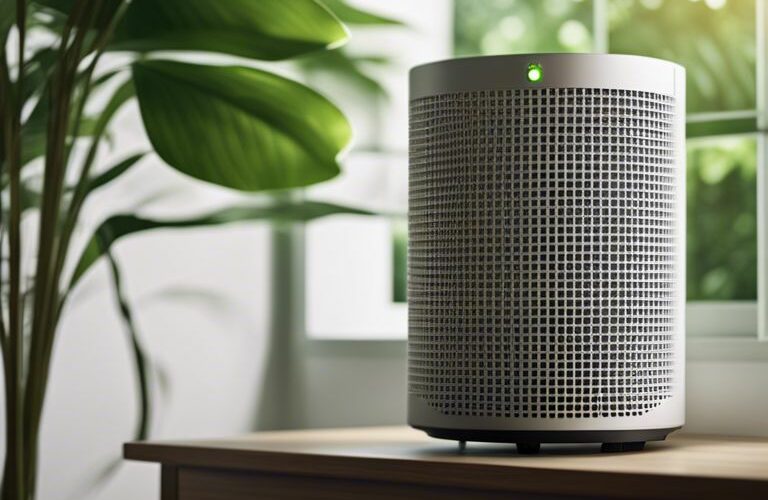Frustrated with the persistent pollutants in your indoor environment? Fear not, for the innovative solution lies in the science behind air purifiers. These remarkable devices are designed to eliminate harmful particles such as dust, pollen, pet dander, mold spores, and other indoor air pollutants. Through a variety of advanced filtration methods, air purifiers are able to improve air quality by capturing and neutralizing these harmful contaminants, leaving your indoor air fresh and clean.
Table of Contents
Understanding Air Purifiers
Air purifiers are devices designed to improve indoor air quality by removing contaminants such as dust, pollen, pet dander, and other harmful particles. They work by filtering the air and trapping these particles, resulting in cleaner and healthier air for breathing.
Definition and Basic Operation
Purifiers are equipped with a fan that draws in the air from the environment and passes it through a series of filters. These filters are designed to capture particles and pollutants, preventing them from recirculating back into the room. The cleaned air is then released back into the environment, providing a continuous cycle of air purification.
Types of Air Purifiers
The types of air purifiers include High Efficiency Particulate Air (HEPA) filters, activated carbon filters, ozone generators, ultraviolet (UV) germicidal irradiation, and ionizers. Each type has its own unique way of removing impurities from the air, whether it’s by physical filtration, chemical adsorption, or through the use of UV light or ionization. Any of these can be effective in improving air quality, depending on the specific needs and concerns of the user.
| HEPA Filters | Activated Carbon Filters |
| Physical filtration of particles | Adsorption of odors and chemicals |
| Effective against allergens and fine dust | Helps remove volatile organic compounds (VOCs) |
| Not effective against odors and chemicals | May release trapped particles back into the air |
| Requires regular replacement | Has a limited lifespan |
| Commonly used in homes and offices | Great for tackling smoke and odor issues |
Plus, it’s important to consider the noise level, energy consumption, and maintenance requirements when selecting an air purifier. These factors can vary depending on the type and model of the purifier, so it’s essential to choose one that meets your specific needs.
The Science of Cleaning Air
Obviously, air purifiers are designed to clean the air in your home or office by removing contaminants and improving overall air quality. But how exactly do they achieve this? Understanding the science behind air purifiers can help you make informed decisions when it comes to choosing the right one for your needs.
Filtration Technologies
With filtration technologies, air purifiers use a variety of filters to capture and remove airborne particles such as dust, pollen, pet dander, and mold spores. HEPA filters are widely considered the gold standard in air purification, capable of trapping 99.97% of particles as small as 0.3 microns. Activated carbon filters are also commonly used to adsorb odors, volatile organic compounds (VOCs), and other gaseous pollutants. Some air purifiers may also feature UV-C light technology to kill bacteria, viruses, and other microorganisms.
When air passes through these filters, the filtration technologies physically and chemically capture or neutralize contaminants, effectively cleaning the air that circulates through the purifier and ultimately improving indoor air quality. Regular maintenance, such as replacing filters as recommended by the manufacturer, is crucial to ensure the continued effectiveness of these filtration technologies.
Non-Filtration Technologies
Activated ozone generators are designed to release ozone gas to chemically react with and neutralize odors and pollutants in the air. However, ozone generators have sparked controversy due to potential health risks associated with elevated ozone levels, and they are not recommended for use in occupied spaces.
Cleaning the air using negative ion generators is another non-filtration technology used in some air purifiers. These devices release negatively charged ions into the air, which attract and bond with positively charged particles such as dust and allergens, causing them to become too heavy to remain airborne and eventually fall out of the air.
It’s important to note that while non-filtration technologies can be effective in removing certain pollutants from the air, they may also produce byproducts or emit substances that could be harmful to human health if not used properly. Careful consideration and understanding of these technologies are essential for safe and effective air purification.
Efficacy and Use Cases
Now, let’s delve into the efficacy and use cases of air purifiers. Understanding what air purifiers can and can’t do, as well as best practices for optimal air quality, is essential for making informed decisions about their use in your home or workspace.
What Air Purifiers Can and Can’t Do
Cases air purifiers are incredibly effective at removing allergens, such as pollen, dust, and pet dander, from the air, which can greatly benefit individuals with allergies or asthma. They can also eliminate odors and harmful volatile organic compounds (VOCs), creating a fresher and healthier indoor environment. However, it’s important to note that air purifiers are not capable of removing all air pollutants, such as carbon monoxide. Additionally, while they can improve air quality in a specific area, they may not have a significant impact on overall air quality in larger spaces.
Best Practices for Optimal Air Quality
Efficacy correct placement of an air purifier is crucial for optimal performance. Be sure to place it in the room where you spend the most time, such as the bedroom or living room, and keep doors and windows closed for maximum efficacy. Additionally, regular maintenance, including filter replacement and cleaning, is essential to ensure that the air purifier continues to operate effectively and improve indoor air quality.
The use of air purifiers is particularly beneficial in homes with pets, individuals with allergies or asthma, or in areas with high levels of outdoor air pollution. Employing best practices for optimal air quality, such as proper placement and maintenance, can maximize the benefits of air purifiers and contribute to a healthier indoor environment.
Environmental and Health Implications
After understanding the technology and mechanisms behind air purifiers, it is important to consider the environmental and health implications of their use. While air purifiers are designed to improve indoor air quality, it is crucial to examine their impact on human health and the environment as well.
Impact on Human Health
Impact on human health is one of the most important considerations when it comes to the use of air purifiers. Poor indoor air quality can lead to a variety of health issues, including respiratory problems, allergies, and aggravation of existing conditions. Air purifiers play a crucial role in removing harmful pollutants and allergens from the air, thus reducing the risk of health problems associated with poor air quality. Additionally, air purifiers can help individuals with respiratory conditions or allergies by creating a cleaner and healthier indoor environment.
Considerations for Environmental Sustainability
Sustainability is a key aspect to consider when evaluating the use of air purifiers. While air purifiers improve indoor air quality, it is important to assess their energy consumption and environmental impact. To ensure environmental sustainability, it is essential to choose air purifiers that are energy-efficient, use eco-friendly materials, and have a minimal impact on the environment. Proper disposal of air filters and components is also crucial to minimize their environmental impact.
To mitigate the environmental impact of air purifiers, it is important to consider factors such as energy efficiency, recyclability, and long-term sustainability when selecting and using air purification systems.
Conclusion
Conclusively, the science behind air purifiers demonstrates their effectiveness in improving indoor air quality. By using technologies such as HEPA filters, activated carbon, UV-C light, and ionizers, air purifiers can remove airborne pollutants, allergens, and odors, thus creating a healthier living environment. Understanding the science behind air purifiers allows consumers to make informed decisions when selecting the right air purifier for their specific needs. As further research and innovation continue, air purifiers will continue to play a crucial role in maintaining clean and safe indoor air quality.
FAQ
Q: What is an air purifier and how does it work?
A: An air purifier is a device that helps improve indoor air quality by removing contaminants such as dust, pollen, pet dander, and other airborne particles. It works by drawing in air, passing it through a series of filters to capture the particles, and then releasing the cleaned air back into the room.
Q: What are the different types of air purifiers available in the market?
A: There are several types of air purifiers, including HEPA (High Efficiency Particulate Air) filters, activated carbon filters, UV-C light purifiers, and ionizers. Each type works differently to remove specific kinds of pollutants from the air.
Q: How do air purifiers improve air quality in indoor environments?
A: Air purifiers improve air quality by reducing the concentration of airborne contaminants, which can lead to a range of health issues such as allergies, asthma, and respiratory problems. They help create a healthier and more comfortable indoor environment by removing pollutants and odors from the air.
Q: Are air purifiers effective against viruses and bacteria?
A: Some air purifiers with UV-C light or ionization technologies have been found to be effective against certain viruses and bacteria. However, it’s important to choose an air purifier with the right features and technologies to effectively address these specific pollutants.
Q: How do I choose the right air purifier for my needs?
A: When choosing an air purifier, consider factors such as the size of the room, the specific pollutants you want to target, and any specific sensitivities or health concerns. Look for a purifier with a HEPA filter and other features tailored to your needs.

Our contributing author is a passionate advocate for eco-friendly living and sustainability. With a background in eco-life, they are dedicated to inspiring and empowering individuals to adopt environmentally conscious lifestyles. Through insightful articles, they share practical tips, innovative solutions, and thought-provoking perspectives to promote a greener, more sustainable world. Join them on the journey towards eco-smart living and discover how small choices can make a big impact. 🌱









